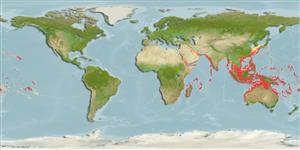Environment: milieu / climate zone / depth range / distribution range
Ekologi
laut; payau berasosiasi dengan karang; kisaran kedalaman 4 - 160 m (Ref. 5222), usually 20 - 45 m (Ref. 5222). Tropical; 36°N - 35°S, 22°E - 124°W
Indo-Pacific: Red Sea to South Africa and eastward to the Pitcairn Group, north to Japan and Korea, south to the Arafura Sea (Ref. 9819), southern Queensland (Australia) and Lord Howe Island.
Length at first maturity / Size / Weight / umur
Maturity: Lm ?, range 16 - ? cm
Max length : 52.0 cm TL jantan/; (Ref. 1238); common length : 22.0 cm TL jantan/; (Ref. 5450); Berat maksimum terpublikasi: 2.0 kg (Ref. 30874)
Duri punggung (Keseluruhan (total)): 11; duri punggung lunak (Keseluruhan (total)): 15-17; Duri dubur 3; Sirip dubur lunak: 8. This species is distinguished by the following characters: body depth 2.8-3.3 in SL (for specimens 10-26 cm SL); head length 2.3-2.6 in SL; flat interorbital area, convex dorsal head profile; snout length 4.3-5.1 in HL; preopercle rounded, rear edge serrate, with lower most serrae slightly enlarged; upper edge of operculum straight; midlateral part of lower jaw with 2-4 rows of teeth; gill rakers of first gill arch 6-8 + 15-17; pyloric caeca 10-16; caudal fin slightly to moderately rounded (Central-Pacific often with truncate caudal fins); ctenoid scales on body except cycloid anterodorsally above lateral line and on thorax and ventrally on abdomen, with numerous auxiliary scales; nape and dorsoposterior part of head densely covered with minute auxiliary scales; lateral-line scales 49-75. Colour variable, ranging from pale greenish grey to pale reddish yellow to scarlet; body often with 5 or 6 faint dark bars, the last on peduncle; body scales (except ventrally) with pale centre and dark rear margin, producing a faint checked pattern; the outer triangular part of interspinous membranes of dorsal fin black (dark red in fish from Western Australia and in some specimens from deep water), with pale yellow or white spot behind tip of each spine (Ref. 39231, 89707, 90102).
Common in outer reef slopes at depths below 15 m, also occurs in protected bays and lagoons as shallow as 4 m. May also be found down to a depth of 160 m. At Madagascar it feeds night and day on brachyuran crabs, fishes, shrimps, and galatheid crabs (Ref. 6774). In Kenyan waters it feeds on crabs, stomatopods, fishes, ophiuroids, and octopus (Ref. 6448). In the Red Sea, mostly fishes and some crustaceans (mainly crabs) are consumed (Ref. 6699). Readily caught with hook-and-line, spear, traps, and gill nets (Ref. 39231)..
Life cycle and mating behavior
Kematangan | Reproduksi, perkembang biakan | Pemijahan | telur-telur | Fecundity | Larva
This species exhibits a combination of simultaneous and sequential hermaphroditism. Smaller individuals within a social group are simultaneous hermaphrodites, while the largest often lose female function and reproduce exclusively as a male (Ref. 103751).
Heemstra, P.C. and J.E. Randall, 1993. FAO Species Catalogue. Vol. 16. Groupers of the world (family Serranidae, subfamily Epinephelinae). An annotated and illustrated catalogue of the grouper, rockcod, hind, coral grouper and lyretail species known to date. Rome: FAO. FAO Fish. Synop. 125(16):382 p. (Ref. 5222)
Status IUCN Red List (Ref. 130435)
ancaman kepada manusia
Reports of ciguatera poisoning (Ref. 30298)
penggunaan manusia
Perikanan: komersial; Ikan buruan: ya; Akuarium: Komersial
Alat, peralatan
laporan khas
muat turun XML
Sumber internet
Estimates based on models
Preferred temperature (Ref.
123201): 24.5 - 29, mean 28 °C (based on 1100 cells).
Phylogenetic diversity index (Ref.
82804): PD
50 = 0.5000 [Uniqueness, from 0.5 = low to 2.0 = high].
Bayesian length-weight: a=0.01148 (0.01022 - 0.01289), b=3.03 (3.01 - 3.05), in cm total length, based on LWR estimates for this species (Ref.
93245).
Trophic level (Ref.
69278): 3.7 ±0.4 se; based on diet studies.
Daya lenting (Ref.
120179): Rendah, Waktu penggandaan populasi minimum 4.5 - 14 tahun (K=0.16).
Fishing Vulnerability (Ref.
59153): Moderate vulnerability (41 of 100).
Climate Vulnerability (Ref.
125649): Moderate to high vulnerability (54 of 100).
Nutrients (Ref.
124155): Calcium = 28.3 [11.7, 59.1] mg/100g; Iron = 0.465 [0.241, 0.959] mg/100g; Protein = 18.4 [16.8, 19.9] %; Omega3 = 0.144 [0.088, 0.237] g/100g; Selenium = 36.8 [20.0, 66.9] μg/100g; VitaminA = 232 [54, 972] μg/100g; Zinc = 1.73 [1.15, 2.43] mg/100g (wet weight); based on
nutrient studies.
